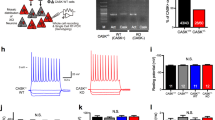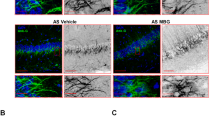Abstract
The Na+/myo-inositol cotransporter (SMIT1) is overexpressed in human Down syndrome (DS) and in trisomy 16 fetal mice (Ts16), an animal model of the human condition. SMIT1 overexpression determines increased levels of intracellular myo-inositol, a precursor of phophoinositide synthesis. SMIT1 is overexpressed in CTb cells, an immortalized cell line established from the cerebral cortex of a Ts16 mouse fetus. CTb cells exhibit impaired cytosolic Ca2+ signals in response to glutamatergic and cholinergic stimuli (increased amplitude and delayed time-dependent kinetics in the decay post-stimulation), compared to our CNh cell line, derived from the cerebral cortex of a euploid animal. Considering the role of myo-inositol in intracellular signaling, we normalized SMIT1 expression in CTb cells using specific mRNA antisenses. Forty-eight hours post-transfection, SMIT1 levels in CTb cells reached values comparable to those of CNh cells. At this time, decay kinetics of Ca2+ signals induced by either glutamate, nicotine, or muscarine were accelerated in transfected CTb cells, to values similar to those of CNh cells. The amplitude of glutamate-induced cytosolic Ca2+ signals in CTb cells was also normalized. The results suggest that SMIT1 overexpression contributes to abnormal cholinergic and glutamatergic Ca2+ signals in the trisomic condition, and knockdown of DS-related genes in our Ts16-derived cell line could constitute a relevant tool to study DS-related neuronal dysfunction.





Similar content being viewed by others
References
Abbott GW, Tai KK, Neverisky DL, Hansler A, Hu Z, Roepke TK, Lerner DJ, Chen Q, Liu L, Zupan B, Toth M, Haynes R, Huang X, Demirbas D, Buccafusca R, Gross SS, Kanda VA, Berry GT (2014) KCNQ1, KCNE2, and Na+-coupled solute transporters form reciprocally regulating complexes that affect neuronal excitability (2014). Sci Signal 7:1–23
Acevedo LD, Holloway HW, Rapoport SI, Shetty HU (1997) Application of stable isotope tracer combined with mass spectrometric detection for studying myo-inositol uptake by cultured neurons from fetal mouse: effect of trisomy 16. J Mass Spectrom 32:395–400
Allen DD, Martin J, Arriagada C, Cárdenas AM, Rapoport SI, Caviedes R, Caviedes P (2000) Impaired cholinergic function in cell lines derived from the cerebral cortex of normal and trisomy 16 mice. Eur J Neurosci 12:3259–3264
Barbara JG (2002) IP3-dependent calcium-induced calcium release mediates bidirectional calcium waves in neurons: functional implications for synaptic plasticity. Biochim Biophys Acta 1600:12–18
Beacher F, Simmons A, Daly E, Prasher V, Adams C, Margallo-Lana ML, Morris R, Lovestone S, Murphy K, Murphy DG (2005) Hippocampal myo-inositol and cognitive ability in adults with Down syndrome: an in vivo proton magnetic resonance spectroscopy study. Arch Gen Psychiatry 62:1360–1365
Berry GT, Mallee JJ, Kwon HM, Rim JS, Mulla WR, Muenke M, Spinner NB (1995) The human osmoregulatory Na+/myo-inositol cotransporter gene (SLC5A3): molecular cloning and localization to chromosome 21. Genomics 25:507–513
Berry GT, Wang ZJ, Dreba SF, Finucane BM, Zimmerman RA (1999) In vivo brain myoinositol levels in children with Down syndrome. J Pediatr 135:94–97
Cárdenas AM, Rodríguez MP, Cortés MP, Alvarez RM, Wei W, Rapoport SI, Shimahara T, Caviedes R, Caviedes P (1999) Calcium signals in cell lines derived from the cerebral cortex of normal and trisomy 16 mice. Neuroreport 10:363–369
Contestabile A, Greco B, Ghezzi D, Tucci V, Benfenati F, Gasparini L (2013) Lithium rescues synaptic plasticity and memory in Down syndrome mice. J Clin Invest 123(1):348–361
Correia SS, Duarte CB, Faro CJ, Pires EV, Carvalho AL (2003) Protein kinase C gamma associates directly with the GluR4 alpha-amino-3-hydroxy-5-methyl-4-isoxazole propionate receptor subunit. Effect on receptor phosphorylation. J Biol Chem 278:6307–6313
Dai G, Yu H, Kruse M, Traynor-Kaplan A, Hille B (2016) Osmoregulatory inositol transporter SMIT1 modulates electrical activity by adjusting PI(4,5)P2 levels. Proc Natl Acad Sci U S A 113:E3290–E3299
Dajas-Bailador FA, Mogg AJ, Wonnacott S (2002) Intracellular Ca2+ signals evoked by stimulation of nicotinic acetylcholine receptors in SH-SY5Y cells: contribution of voltage-operated Ca2+ channels and Ca2+ stores. J Neurochem 81:606–614
Dickinson JA, Hanrott KE, Mok MH, Kew JN, Wonnacott S (2007) Differential coupling of alpha7 and non-alpha7 nicotinic acetylcholine receptors to calcium-induced calcium release and voltage-operated calcium channels in PC12 cells. J Neurochem 100:1089–1096
Downing JE, Role LW (1987) Activators of protein kinase C enhance acethylcholine receptor in sympathetic ganglion neurons. Proc Natl Acad Sci U S A 84:7739–7773
Epstein CJ (1986) In: Epstein CJ (ed) Introduction in the neurobiology of Down syndrome. Raven Press, N. Y, pp 1–15
Fenster CP, Beckman ML, Parker JC, Sheffield EB, Whitworth TL, Quick MW, Lester RA (1999) Regulation of alpha4beta2 nicotinic receptor desensitization by calcium and protein kinase C. Mol Pharmacol 55:432–443
Fisher SK, Novak JE, Agranoff BW (2002) Inositol and higher inositol phosphates in neural tissues: homeostasis, metabolism and functional significance. J Neurochem 82:736–754
Gomes AR, Correia SS, Esteban JA, Duarte CB, Carvalho AL (2007) PKC anchoring to GluR4 AMPA receptor subunit modulates PKC-driven receptor phosphorylation and surface expression. Traffic 8:259–269
Gueorguiev VD, Zeman RJ, Meyer EM, Sabban EL (2000) Involvement of alpha7 nicotinic acetylcholine receptors in activation of tyrosine hydroxylase and dopamine beta-hydroxylase gene expression in PC12 cells. J Neurochem 75:1997–2005
Hattori M, Fujiyama A, Taylor TD, Watanabe H, Yada T, Park HS, Toyoda A, Ishii K, Totoki Y, Choi DK, Groner Y, Soeda E, Ohki M, Takagi T, Sakaki Y, Taudien S, Blechschmidt K, Polley A, Menzel U, Delabar J, Kumpf K, Lehmann R, Patterson D, Reichwald K, Rump A, Schillhabel M, Schudy A, Zimmermann W, Rosenthal A, Kudoh J, Schibuya K, Kawasaki K, Asakawa S, Shintani A, Sasaki T, Nagamine K, Mitsuyama S, Antonarakis SE, Minoshima S, Shimizu N, Nordsiek G, Hornischer K, Brant P, Scharfe M, Schon O, Desario A, Reichelt J, Kauer G, Blocker H, Ramser J, Beck A, Klages S, Hennig S, Riesselmann L, Dagand E, Haaf T, Wehrmeyer S, Borzym K, Gardiner K, Nizetic D, Francis F, Lehrach H, Reinhardt R, Yaspo ML (2000) The DNA sequence of human chromosome 21. Nature 405:311–319
Huang H, Alexander GE, Daly EM, Shetty HU, Krasuski JS, Rapoport SI, Schapiro MB (1999) High brain myo-inositol levels in the predementia phase of Alzheimer’s disease in adults with Down’s syndrome: a 1H-MRS study. Am J Psychiatry 156:1879–1886
Huang W, Galdzicki Z, van Gelderen P, Balbo A, Chikhale EG, Schapiro MB, Rapoport SI (2000) Brain myo-inositol level is elevated in Ts65Dn mouse and reduced after lithium treatment. Neuroreport 11:445–448
Lamar M, Foy CM, Beacher F, Daly E, Poppe M, Archer N, Prasher V, Murphy KC, Morris RG, Simmons A, Lovestone S, Murphy DG (2011) Down syndrome with and without dementia: an in vivo proton magnetic resonance spectroscopy study with implications for Alzheimer’s disease. NeuroImage 57:63–68
Lan JY, Skeberdis VA, Jover T, Grooms SY, Lin Y, Araneda RC, Zheng X, Bennett MV, Zukin RS (2001) Protein kinase C modulates NMDA receptor trafficking and gating. Nat Neurosci 4:382–390
Lin AL, Powell D, Caban-Holt A, Jicha G, Robertson W, Gold BT, Davis R, Abner E, Wilcock DM, Schmitt FA, Head E (2016) (1)H-MRS metabolites in adults with Down syndrome: effects of dementia. Neuroimage Clin 2:728–735
Lubrich B, van Calker D, Peschka-Süss R (2000) Inhibition of inositol uptake in astrocytes by antisense oligonucleotides delivered by pH-sensitive liposomes. Eur J Biochem 267:2432–2438
Marszalec W, Yeh YZ, Narahashi T (2005) Desensitization of nicotine acetylcholine receptors: modulation by kinase activation and phosphatase inhibition. Eur J Pharmacol 514:83–90
McVeigh KE, Mallee JJ, Lucente A, Barnoski BL, Wu S, Berry GT (2000) Murine chromosome 16 telomeric region, homologous with human chromosome 21q22, contains the osmoregulatory Na(+)/myo-inositol cotransporter (SLC5A3) gene. Cytogenet Cell Genet 88:153–158
Montiel C, Mendoza I, Garcia CJ, Awad Y, García-Olivares J, Solís-Garrido LM, Lara H, García AG, Cárdenas AM (2003) Distinct protein kinases regulate SNAP-25 expression in chromaffin cells. J Neurosci Res 71:353–364
Nakayama H, Okuda H, Nakashima T (1993) Phosphorylation of rat brain nicotinic acetylcholine receptor by cAMP-dependent protein kinase in vitro. Brain Res Mol Brain Res 20:171–177
Okubo Y, Kakizawa S, Hirose K, Iino M (2001) Visualization of IP(3) dynamics reveals a novel AMPA receptor-triggered IP(3) production pathway mediated by voltage-dependent Ca2+ influx in Purkinje cells. Neuron 32:113–122
Opazo P, Saud K, de Saint Pierre M, Cárdenas AM, Allen DD, Segura-Aguilar J, Caviedes R, Caviedes P (2006) Knockdown of amyloid precursor protein normalizes cholinergic function in a cell line derived from the cerebral cortex of a trisomy 16 mouse, an animal model of Down syndrome. J Neurosci Res 84:13031310
Popp RL, Reneau JC, Brotherton BJ (2008) Activation of protein kinase C enhances NMDA-induced currents in primary cultured cerebellar granule cells: effect of temperature and NMDA NR2 subunit composition. Eur J Pharmacol 599:1–10
Rojas G, Cárdenas AM, Fernández-Olivares P, Shimahara T, Segura-Aguilar J, Caviedes R, Caviedes P (2008) Effect of the knockdown of amyloid precursor protein on intracellular calcium increases in a neuronal cell line derived from the cerebral cortex of a trisomy 16 mouse. Exp Neurol 209:234–242
Sago H, Carlson EJ, Smith DJ, Kilbridge J, Rubin EM, Mobley WC, Epstein CJ, Huang TT (1998) Ts1Cje, a partial trisomy 16 mouse model for Down syndrome, exhibits learning and behavioral abnormalities. Proc Natl Acad Sci USA 95:6256–6261
Santin MD, Valabrègue R, Rivals I, Pénager R, Paquin R, Dauphinot L, Albac C, Delatour B, Potier MC (2014) In vivo 1H MRS study in microlitre voxels in the hippocampus of a mouse model of Down syndrome at 11.7 T. NMR Biomed 27:1143–1150
Saud K, Arriagada C, Cárdenas AM, Shimahara T, Allen DD, Caviedes R, Caviedes P (2006) Neuronal dysfunction in Down syndrome: contribution of neuronal models in cell culture. J Physiol Paris 99:201–210
Schuchmann S, Müller W, Heinemann U (1998) Altered Ca2+ signaling and mitochondrial deficiencies in hippocampal neurons of trisomy 16 mice: a model of Down’s syndrome. J Neurosci 18:7216–7231
Shetty HU, Holloway HW, Acevedo LD, Galdzicki Z (1996) Brain accumulation of myo-inositol in the trisomy 16 mouse, an animal model of Down’s syndrome. Biochem J 313:31–33
Shetty HU, Siarey RJ, Galdzicki Z, Stoll J, Rapoport SI (2000) Ts65Dn mouse, a Down syndrome model, exhibits elevated myo-inositol in selected brain regions and peripheral tissues. Neurochem Res 25:431–435
Shonk T, Ross BD (1995) Role of increased cerebral myo-inositol in the dementia of Down syndrome. Magn Reson Med 33:858–861
Sun L, June Liu S (2007) Activation of extrasynaptic NMDA receptors induces a PKC-dependent switch in AMPA receptor subtypes in mouse cerebellar stellate cells. J Physiol 583:537–553
Acknowledgments
This study is funded by Fondecyt (Chile) grant nos. 1040862 and 1130241, Enlaces ENL 07/05 (Univ. of Chile), CNRS/Conicyt Exchange Program, Fondation J. Lejeune (France), and P09-022-F from ICM-ECONOMIA, Chile. The Centro Interdisciplinario de Neurociencia de Valparaíso (CINV) is a Millennium Institute supported by the Millennium Scientific Initiative of the Ministerio de Economía, Fomento y Turismo. Pablo Caviedes holds patent protection on the CNh and CTb cell lines. The authors wish to thank Mr. Fernando Guzmán for his valuable technical assistance.
Author information
Authors and Affiliations
Corresponding author
Rights and permissions
About this article
Cite this article
Cárdenas, A.M., Fernández-Olivares, P., Díaz-Franulic, I. et al. Knockdown of Myo-Inositol Transporter SMIT1 Normalizes Cholinergic and Glutamatergic Function in an Immortalized Cell Line Established from the Cerebral Cortex of a Trisomy 16 Fetal Mouse, an Animal Model of Human Trisomy 21 (Down Syndrome). Neurotox Res 32, 614–623 (2017). https://doi.org/10.1007/s12640-017-9775-0
Received:
Revised:
Accepted:
Published:
Issue Date:
DOI: https://doi.org/10.1007/s12640-017-9775-0




